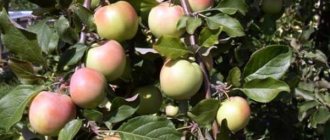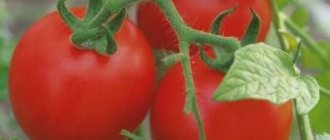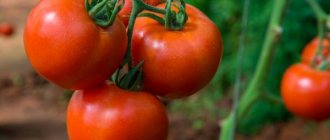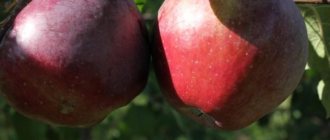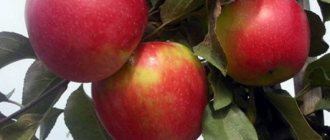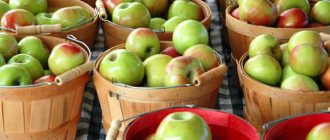It is with great pleasure that I get acquainted with numerous publications about the apple tree. It's interesting when points of view are different. And when experts share their correct approaches. And amateur gardeners - with their experience.
After all, the purposes of planting apple trees are different . But there are also common points.
Everyone likes:
- Beautiful, large and tasty fruits;
- Abundant and annual harvests;
- So that you don’t get sick and pests don’t eat;
- So that they can be stored longer (well, I really want to eat my apples on March 8);
- I don’t really want to plant tall-growing ones: Then try to process and remove tall-growing apples. And at the top they are always the best.
What kind of garden should I grow? Traditional approach - 5-8 apple trees on vigorous rootstocks:
- A couple of summer ones;
- 1-2 autumn;
- 3-5 winter.
But there are many innovators. And they think that dwarf is a level. And the same area will allow you to plant 10-15 apple trees:
- 2-3 year olds;
- 2-3 autumn;
- 6-9 winter.
Advice! With all options, you will be recommended to plant the Orlovim variety.
Apple tree Orlovim
In this section we will present you with a photo and description of the variety . Meet:
- Year of birth 1977;
- Created by the All-Russian Research Institute;
- Included in the State Register of Selection Achievements for the Central Region of Russia in 1989;
- Antonovka vulgare in parents;
- So far he has no relatives. There is a slight resemblance to Melba.
Apple tree Orlovim.
And now about the tree itself:
- A medium- sized, round tree. Branches of different lengths are spaced sparsely. Sometimes they move away from the trunk at an angle of 90 degrees;
Important! You won’t see it high – no more than 5 m;
- The root system is powerful: both horizontal and vertical roots (even over 4 m).
- Fruits - on average 120-140 g . There are also more than 150 g, and even 180 g. Flat-elongated shape. Most often with uneven sides. Red stripes are striking. And the blush is a little blurry. The surface of the fruit has slight ridges;
- The color of the pulp is cream;
- The taste is sweet with sourness and a characteristic aroma, slightly reminiscent of Antonovka. The creamy flesh is soft and very juicy. The skin is oily and thin. And there is enough sugar;
- Ripening from the second half of August . You will often be able to consume them until the end of September.
Watering trees
The irrigation regime depends on the type of soil and climatic characteristics of the region. On average, for one watering you need:
- for an annual seedling – 2-3 buckets;
- two-year-old Orlovim apple tree - 4-5 buckets of water;
- for adult apple trees - approximately 60 liters per square meter of trunk circle. The soil should be saturated with water to about 60-80 cm.
It is important not only to pour out the required amount of water, but also to do it on time. The first time the soil is moistened is when the Orlovim apple tree has finished blooming. The next watering is carried out when the trees already have ovaries.
Important! If there is not enough water, the tree may drop its fruits.
The trees are watered for the third time after the harvest, before the autumn frosts. Thanks to watering, the Orlovim apple tree will better withstand frost.
Watering the apple tree is carried out around the circumference of the crown. To do this, dig a groove 10-15 cm deep, and you need to dig carefully so as not to damage the root system. Water is poured in portions. After watering, the soil must be loosened.
additional characteristics
Advantages and disadvantages
So, what kind of apple tree is Orlovim? Like any other variety, it has its pros and cons.
Why you might like it:
- Immunity to scab;
- Frost resistance at the highest level;
- Begins to bear fruit early;
- The yield is fine;
- The appearance is quite marketable;
- Good taste.
Orlovim is immune to scab.
Disadvantages or features to consider:
- You won't be able to store them for a long time. About a month, they are not winter;
- The height is still decent, which makes caring for them more difficult;
- Immunity to scab weakens with age.
Advice! Trees of this variety do not need protection from frost. But be sure to wrap it up against rodents. And also whiten it in winter.
Tree height
- No more than 5 m on a vigorous rootstock;
- Mostly medium height;
- With good growth rates.
Crown width
- The shape is round, spherical;
- Medium density and up to 6 m in diameter.
Krona Orlovim.
Productivity
- Abundantly and annually;
- With good care, you can harvest up to 100 kg . From a 9-12 year old tree.
Self-pollinating
- What this variety does not have is the ability to self-pollinate. But solve this problem by planting other varieties nearby: late summer varieties are especially suitable. If you don’t like this name, call it early autumn.
Tasting assessment
We are all different in taste and color. Anyone who has been watching figure skating for a long time continues to be amazed at the grading system. Specialists are high-class judges, but their assessments are different.
So it is with Orlov:
- For taste - 4.4-4.6 points;
- For artistry (appearance) – 4.3.
Winter hardiness
Only positive reviews. To say that it endures winter well is simply an understatement. severe winters with temperatures below 30 degrees in the air and up to 35 on the surface without damage. Unlike Melba.
Disease resistance
This variety not only exhibits high disease resistance. He is immune to such a dangerous disease as scab. He was raised that way. And the four scab races (all that exist in Russia) are not afraid of him. This is on vigorous rootstocks.
Advantages and disadvantages
“Orlovim”, like any variety, has its advantages and disadvantages.
The main advantage is resistance to scab. No less valuable is the fact that the fruits are very aromatic, have a good sweet and sour taste and are universally used: excellent for making jams, juices, preserves, marmalade and as a filling for pies. Also, experts and summer residents note high winter hardiness, early fruiting and abundant harvests.
Consumer ripeness occurs almost immediately after picking, but maximum taste appears after a few days.
The disadvantages are the low shelf life of apples - no more than 3-4 weeks and their fragility. Harvesting must be done carefully, as fruits can be seriously damaged if they fall to the ground.
Reviews
Anna Anatolyevna. The Orlovim apple tree variety is a great find for beginning gardeners. No special care is required. Frost resistance is high. I would especially like to note that it is absolutely resistant to scab. And to other diseases, more or less... Among summer apples, it is perhaps the best. Even though it's late summer. The taste is very pleasant and juicy. It’s not even comparable to Melba – in size and taste. Yes, and in terms of safety.
Igor Petrovich. If I were to start a garden now... I would definitely plant a couple of summer varieties, Orlovim. This is a godsend for a gardener. The white filling is receding... And there’s more hassle with it. Even more so for Yaroslavl. Got vaccinated. The very next year they bloomed profusely. The ovary was regulated. And the apples grew massive (up to 300 g!). Juicy, with pleasant pulp. Although they seemed a bit sour. Maybe it rains... It bears fruit every year and does well. And scab is not terrible.
Anatoly. A lot is written about new varieties of apple trees. And the Orlovim variety is often mentioned. At first I thought it was a spelling mistake. Maybe Orlov? Or maybe Orlov? I don’t know for sure. But I know for sure that this variety deserves to be grown in your garden. Resistant to scab and frost. It bears fruit every year and quite well. I recommend!
Diseases and pests of the variety
The variety is considered resistant to fungal diseases, including scab. But with age, the tree’s immunity may weaken. Therefore, it is advisable to periodically treat the garden against pests and diseases as a preventive measure. The first spraying against fungal diseases is carried out in the spring on a bare tree.
This should be a solution of Bordeaux mixture (1%), copper sulfate or any other composition containing copper. After a week, they are treated with general-purpose insecticides against pests. After the first leaves appear and before flowering, you need to carry out another similar treatment.
During flowering, the tree is not treated so as not to harm the bees. But a day after the flowers begin to fall, treatment is carried out against the codling moth. Spraying against this pest is carried out several more times during the season. This is necessary, since the codling moth lays eggs and raises as many as 3 generations over the summer.
Read more about how to get rid of rotting apples.
Main diseases of apple trees:
- scab;
- rust;
- monilial burn;
- powdery mildew.
Scab is the most common, but this variety is resistant to it. The disease appears as olive and velvety spots on the leaves and dark, unsightly spots on the fruit. Infected fruits fall off. The fungus that causes the disease is especially active in humid and rainy weather. The tree is treated for scab, as well as for other fungal diseases, with a 1% solution of Bordeaux mixture. Rust affects the leaves and fruits of apple trees, leaving rusty spots on them.
1 - scab; 2 - rust; 3 - monilial burn; 4 - powdery mildew. Such leaves and fruits are removed, and the tree is treated with copper-containing solutions. Powdery mildew appears in warm and humid times. Its main symptom is a flour-like coating on the leaves. Good crown thinning, which guarantees high-quality air circulation, protects against disease. Unfortunately, trees cannot be protected 100% from contact with insects.
Therefore, farmers use different ways to combat them:
- attract birds to the garden by placing feeders;
- hang traps with pheromones that attract insects;
- spray trees with insecticides if pests are detected.
We recommend that you find out who the codling moth is.
Features of planting and care
Landing
Deadlines
Like many other apple trees, plant them taking into account local conditions and weather conditions:
- In spring from the end of April. And in the first half of May;
- In autumn, planting is more successful in the southern regions.
Watch the video on how to properly plant an apple tree in spring:
And a video on how best to plant an apple tree in the fall:
Attention! Be sure to consider the time for rooting seedlings. And they need 25-30 days before frost.
Technology
- Choose a place in the sun . The variety is very responsive to full lighting and good ventilation. As they say, he is not used to remaining in the shadows;
- Don't forget to take into account the groundwater level. It loves watering, but the planting site should not be a place for collecting water;
- The soil is more suitable loamy and sandy loam . Acidity – 5.6-6.0 pH.
Apple tree planting diagram.
Experts advise doing everything sedately and thoroughly:
- Prepare the planting hole ahead of time: Dig it 3-4 weeks before planting (width -50-70 cm, depth - up to a meter);
- Fill with compost, humus, ash, mineral fertilizers (superphosphate, nitroamophoska, urea).
- Each row is 3 meters apart, and between the rows is about 5 meters.
Important! The earth will definitely shrink. Therefore, make sure that the root collar is at a distance of about 7-10 cm from the ground level.
Growing
- Features determine its merits;
- And don’t forget that Orlovim is a scab-immune variety. And this gives you the opportunity not to use chemistry for this common disease.
And further:
- Carry out a set of measures against pests at the beginning of the growing season.
Agricultural technology
Traditional. Everyone plans:
- When to prune and what kind;
- Measures to protect against pests and diseases (whitewashing trunks, spraying with fungicides and insecticides);
- Watering (several abundant waterings per season depending on weather conditions);
- Top dressing (both root when digging tree trunk circles, and foliar when spraying);
- Loosening and mulching.
Water the apple tree depending on the weather.
If you have experience growing apple trees, and not just eating them, you will have fewer problems with this variety.
Crown formation
What appearance the crown of your apple tree will take depends on you:
- But the sparse-tiered variety is more suitable for this variety;
- True, the spindle-shaped one also looks very nice;
- You can surprise your friends with a whole row near your house. In the form of a palmette.
Sparsely tiered crown.
Note to self:
- Give the whole tree a year to grow freely;
- Control the sharpness of the skeletal branches from the trunk. To prevent breaks.
Watch the video on how to properly form the crown of an apple tree:
How to prune a young apple tree?
Having decided on the form, you will be able to lay down future harvests from a young age. Apply green operations:
- Pinch and break off carefully;
- Shorten the side branches extending from the trunk at an angle of about 90 degrees by only 3-4 cm: And do not touch the central conductor.
Remember!
- Pinch on the outer bud;
- Perform pruning before sap flow begins in the spring.
Planting seedlings
When choosing a place for a seedling of the Orlovim variety, special attention should be paid to the level of illumination of the area. It is this indicator that affects the yield and taste of Orlovim fruits.
Since this variety does not tolerate highly moist soils, seedlings are planted on hills or a good drainage layer is provided. The optimal soil option for the Orlovim variety is chernozem, loamy or sandy loam soil.
Soil preparation
To ensure that the seedling takes root easily, the planting hole is prepared in advance. Suitable pit parameters: diameter 0.6-0.8 m, depth - 0.5-0.6 m. Moreover, it is advisable to stack the fertile and lower layers of soil separately.
A small layer of drainage is laid at the bottom of the hole (especially important if the groundwater is shallow). First fill up the top fertile layer of soil. The remaining soil is thoroughly mixed with humus, compost, ash and mineral fertilizer are added.
Planting stages:
- The root of the Orlovim variety seedling is carefully examined. Sections should be white. If there is a brown tint, it means the root has been damaged and needs to be shortened a little using pruners or a knife.
- First, drive a stake into the center of the hole - this will be a support for the seedling. Then the tree is lowered into the hole and the roots are carefully straightened.
- The hole is filled with a fertile mixture. The soil around the Orlovim variety seedling is compacted.
- A small depression in the form of a ditch is made around the circumference of the pit. Thanks to this, moisture will be absorbed in the right place.
- The surface of the ground around the seedling is watered and mulched with sawdust or peat.
Important! The root collar of the Orlovim apple tree should be above ground level.
Features of ripening and fruiting
Beginning of fruiting
- You can see apples already in the 3rd year after planting . Admire and expect full harvests;
- And, of course, try it.
Pollinator varieties
Apple trees of the Orlovim variety are self-sterile. they need neighbors as pollinators It could be:
- Pepin saffron;
- Welsey;
- Scarlet anise.
Pepin saffron.
Welsey.
Scarlet anise.
Do not rush to be upset if these varieties are not available. And many others are coming.
Important! Experts also use artificial pollination. Then there will be more apples. And they are bigger.
Deadlines
Blooms
The blossoming of the apple tree leaves no one indifferent. This happens in the first half of May.
Don't miss the opportunity to visit the garden when the apple trees are in bloom. Smell the flowers and listen to the buzzing bees!
Flowering Orlovim.
Fruit ripening
The fruits do not all ripen at once. And this happens:
- From the second half of August - removable maturity (still a little greenish color );
- Until mid-September – consumer maturity ( light yellow color of apples).
Fruit storage
Your task is to properly use the opportunities provided to process these valuable apples. They remain in good temperature conditions for up to a month.
Here you go:
- Juices;
- Jams;
- Jam;
- Confitures.
Fruiting
The variety deserves special attention:
- Rapid entry into fruiting;
- High productivity;
- And it makes me happy every year.
Pollination specifics and yield indicators
The Orlovim apple tree pleases gardeners with abundant annual harvests. A 10-year-old tree produces from 60 to 80 kg of apples, and 100 kg can be harvested from an older apple tree . In the garden, 200 centners of ripe fruits are collected from one hectare. Apples are tasty, but not very shelf-stable. They can be stored for no more than a month.
Since the variety is self-sterile , its flowers definitely need additional cross-pollination. In order for the tree to bear fruit regularly, it is necessary to plant other apple trees in the garden with a similar flowering period, for example, “Welsey” or “Pepin saffron”.
Subspecies and options
On a dwarf rootstock
Apple trees grafted onto vegetatively propagated low-growing rootstocks are usually called:
- Dwarfs - on Paradise;
- Semi-dwarf - on Dusen.
They are good:
- They begin to bear fruit earlier – already in the second year;
- It is more convenient to care for them;
- You can plant even with high groundwater;
- You can plant more varieties in the same area.
But don't forget! The value of the developed Orlovim variety lies in its exceptional frost resistance and the possibility of planting in regions with harsh climates.
And again, your wishes and desires will put everything in its place.
Summer and late summer
There are different names for the ripening periods of the Orlovim apple tree - late summer and early autumn. Even autumn. And they are true. Ultimately what matters is:
- Ripens in late summer;
- We collect and use in early autumn;
- And there are also different regions. So let's plant and enjoy the wonderful fruits. And late in summer and early in autumn.
Description of the variety and its characteristics
The history of the Sinap Orlovsky variety began in 1955, when a group of scientist-breeders from the All-Russian Research Institute named after. I. Michurina tried to breed a hybrid that had similar taste and appearance to Northern Sinap, but had higher frost resistance.
To do this, they crossed Northern Sinap with another, no less remarkable type of crop - Memory of Michurin, as a result of which this winter-hardy variety appeared, listed in the State Register of Russia in 1979 for cultivation over a vast area of our country.
Description of the tree
The trees of this variety are stunningly beautiful, especially during flowering:
- they are huge (up to 5 m high), so they require a lot of space;
- strong thick branches form a massive spreading crown, shaped like a ball;
- There are not very many leaves on the tree. This allows sunlight to flow unimpeded into the center of the tree;
- dark green leaves, large, oval-shaped with carved edges and pointed ends, covered with a light edge;
- the flowers are also large, pale pink, forming inflorescences;
- flowering occurs at the end of May and lasts about a week;
- the variety has flowers of both male and female types of flowering, however, for better fruiting, other varieties of apple trees are planted next to Sinap Orlovsky - Antonovka, Slavyanka, Pepin Saffron or Welsey;
- Fruiting begins early - already 4 years after planting you can get the first apples.
Description of fruits
The fruits of Sinap Orlovsky deserve special attention:
- in comparison with Sinap Northern, whose fruits are heterogeneous in weight and shape, the apples of Sinap Orlovsky have the same size and a beautiful round, slightly flattened shape;
- the average weight of apples is about 170 g;
- When ripe, the fruits have a yellow-green color with a beautiful pink blush. After they sit for a while, the color of the apples becomes golden;
- the juicy and tender pulp of the fruit is covered with a dense skin, which is not felt at all when eating;
- The taste of apples is richly sweet with some sourness and a unique apple aroma.
100 g of fruit pulp contains:
- sugars - not less than 9.5%;
- acids - 0.5%;
- vitamin C - 13.5 mg;
- pectin - about 9%;
- active substance - 190 mg.
Taste qualities according to a five-point system are rated at 4.7 points.
Usage
Sinap Orlovsky apples are tasty and very healthy when eaten fresh. Due to their valuable chemical composition, they are used in dietary and baby food, as well as in folk medicine.
The fruits of this variety make excellent aromatic jam. Compotes, purees, jams and jams are prepared from them. Juice is squeezed out of fruits of this variety, dried and soaked, and added to baked goods and fruit salads.
Ripening and harvesting dates
Apples begin to ripen in September. Mass ripening occurs at the end of the month. Then they begin to harvest. If the fruits are not picked in time, they will not fall off and will not lose their presentation and taste even when severe frosts strike.
Productivity
The variety produces amazing yields. Trees begin to bear fruit already 4 years after planting, and the yield will increase every year. From a tree 6-8 years old and older, 150 or more kilograms of fragrant fruits are collected. It is possible to collect up to 160 centners from one hectare.
Shelf life and transportability
Sinap Orlovsky apples can be stored until spring. At the same time, they do not lose either their appearance or taste, which is very much appreciated by farmers who grow the variety on a commercial scale. The fruits tolerate transportation well over long distances.
Growing in different regions
In Siberia
Scientists saw the task of developing a variety for Central Russia. But it was zoned after many years of testing in Central Russia.
But the use of slate (creeping) forms in Siberia is, first of all, a search for ways to protect against freezing in these harsh conditions.
In the Leningrad region
Here varieties of Oryol selection are in high demand . And this is understandable. And the Orlovim variety has its own trump cards to be loved there. Just look at the immunity to scab and good frost resistance.
Belarus
Also here. Long-term tests of the variety confirmed its reliability . On par with the Central regions of Russia.
Orlovim, grown in Belarus.
Fruits and their taste
The apples are medium in size, light yellow in color with rich blush on the sides and splashes. The weight of the apple is 130-150 g, there are also fruits weighing 180 g. They are conical in shape, slightly flattened at the base and below. There are apples with a slight slant at the base.
The peel is thin, with a small ribbed surface. There is gloss and oiliness. Funnel of medium depth, pointed.
The pulp is juicy, creamy, tender, without noticeable graininess. The seeds are small. Apples taste sweet and sour, much depends on the degree of ripening. There is a strong apple aroma.
Nuances and questions from readers
Where can I buy?
This variety is offered mainly by nurseries in Central Russia. Here are some:
- Grandfather's garden in the Moscow region (area of the village of Vysokovo, Chekhov district); Fruit nursery Lyakhi, Melenkovsky district, Vladimirov region - about 400-500 rubles. (e-mail: [email protected] ). Representatives work in both the Ryazan and Nizhny Novgorod regions;
- Egoryevsky nursery Nikitenko Alexandra, Moscow region, Egoryevsky district, Efremovskaya village ( [email protected] );
- Nursery Sad-Elita (Dar-Nadezhda) or “Bearded Garden” - 70 UAH for M26 rootstock.
Advice! You need to start communicating with nurseries in August (pre-orders).
Description of the variety Slava Primorye
The apples of Slava Primorye are beautiful and very tasty, they have high commercial and consumer qualities, although they quickly crumble and can hardly be preserved for a long time. Recommended for household plots and small farms focused on the production of juice or compotes.
Apples: what they look like
The skin is dense, hard, thick, not very elastic. It is green or greenish-yellow in color when ripe. The outer blush is dark red, pinkish-red or slightly crimson, streaked, may be slightly blurred, dense, occupying at least 70-85% of the surface. Subcutaneous points are numerous, they are located very densely, have a grayish-green or gray tint, and are clearly visible. Professionals recommend assessing the chemical composition using the following initial data:
- P-active substances – 3170 milligrams.
- Ascorbic acid (vitamin C) – 7 grams.
- Sugar (fructose) – 13.4%.
- Titratable acids – 0.78%.
- Pectins (fiber) – 14.2%.
The pulp is most often white or white-green, dense, fine-grained, and very juicy. The taste is sweet and sour, with a strong bias towards sourness, the aroma is of medium intensity or even weak, but characteristic, well recognizable and pleasant. The taste is considered dessert, the unofficial tasting score is 4.4-4.5 points out of five possible.
Apple tree Slava Primorye: characteristics
Crown and root system
The tree is usually classified as vigorous, although it never grows higher than 5-6 meters. Most gardeners prefer to trim Slava to 3.5-4 meters to make it more convenient to care for it and harvest. The shape of the crown is dense, round or round-oval, can be broadly oval, over the years it becomes spreading, and sometimes even weeping. The branches are of medium length and thickness, straight, look powerful, covered with green or greenish-brown bark with pubescence in some places. Fruits on ringlets.
The leaves are medium-sized, oval, slightly elongated, dense, leathery, green or dark green in color. The tips are long-pointed, can be twisted with a screw, the edges are serrated, jagged, crenate, or wavy. The root system is powerful, deeply recessed, taprooted, but depending on the rootstock, it can be fibrous and is well adapted to seeking moisture.
Productivity and pollination
For Far Eastern and northern apple trees in general, the early fruiting and productivity of the variety are excellent.
A special advantage of the variety is its complete independence from outside pollinators. The apple tree is quite capable of self-pollinating and producing good harvests even when there are no other apple trees in the area that are suitable for flowering. Many gardeners say that having other varieties will increase yields, but only slightly.
Winter hardiness and disease resistance
The tree has very good resistance to low temperatures and will tolerate frosts down to -30-35°C even without special shelter, even if they last longer than 3-5 weeks in a row. However, it is still better to properly prepare apple trees for wintering, especially in such difficult-to-grow regions as the Far East or Siberia.
It is believed that Slava Primorye has very high rates of resistance to various fungal infections of apple trees. However, it cannot resist bacterial bark cancer. And some other diseases, as well as pests, may well damage trees, so it is better to carry out preventive treatments with insecticides and fungicides in a timely manner.
The variety is considered semi-cultivated; no subspecies are known, at least there is no official information about it. You can grow Slava on different rootstocks, from standard standard ones to hybrids on pear or even rowan. In this case, you can achieve several different indicators, for example, in the size of the tree, fruits, the speed of their ripening, and winter hardiness.
History of the variety's creation
The Orlovim apple tree variety was developed more than 35 years ago.
It was obtained by crossing the Antonovka common apple tree and the seedling SR 0523 in 1977 at the All-Russian Research Institute. Its authors are E. N. Sedov, Z. M. Serova, V. V. Zhdanov. In 1999, Orlovim was included in the State Register of Breeding Achievements for the Central Region of Russia (after testing in the middle zone in 1989). The Orlovim apple tree variety currently has no varieties, but there is a very similar variety - Melba. Its characteristic differences are low resistance to scab and powdery mildew. In addition, Melba is less frost-resistant. It requires careful care.
Harvest and storage
Orlovim begins to bear fruit early - 3 years after planting. The first harvest will not be very large, only a couple of kilograms. In the next decade, the tree will increase its yield. In adult apple trees it is up to 190 c/ha. The fruits ripen at the end of August. If the weather is cool and rainy, delay harvesting until the weather becomes dry. This will increase the shelf life of the fruit.
Orlovim apples can be stored for 1–1.5 months. Plan to process or consume them first if you have a harvest from several different varieties of apple trees. Fruits without damage are selected for storage. All fruits damaged or with traces of pests are eaten immediately. Boxes with apples are installed in a basement, garage, barn with low air temperature - about 0 ° C and humidity above 70%.
Important! Collected apples cannot be placed closely in the boxes - there must be free space between them.
Caring for and planting apple trees is not at all difficult; even a beginner can handle planting and caring for them. And if you have enough space for two apple trees, then by following simple tree care recommendations, you will be provided with a guaranteed harvest of delicious, aromatic fruits every year.



